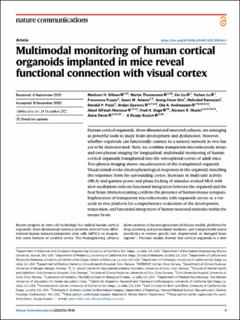Multimodal monitoring of human cortical organoids implanted in mice reveal functional connection with visual cortex
Wilson, Madison N.; Thunemann, Martin; Liu, Xin; Lu, Yichen; Puppo, Francesca; Adams, Jason W.; Kim, Jeong-Hoon; Ramezani, Mehrdad; Pizzo, Donald P.; Djurovic, Srdjan; Andreassen, Ole; Mansour, Abed AlFatah; Gage, Fred H.; Muotri, Alysson R.; Devor, Anna; Kuzum, Duygu
Journal article, Peer reviewed
Published version

Åpne
Permanent lenke
https://hdl.handle.net/11250/3047188Utgivelsesdato
2022Metadata
Vis full innførselSamlinger
- Department of Clinical Science [2295]
- Registrations from Cristin [9489]
Sammendrag
Human cortical organoids, three-dimensional neuronal cultures, are emerging as powerful tools to study brain development and dysfunction. However, whether organoids can functionally connect to a sensory network in vivo has yet to be demonstrated. Here, we combine transparent microelectrode arrays and two-photon imaging for longitudinal, multimodal monitoring of human cortical organoids transplanted into the retrosplenial cortex of adult mice. Two-photon imaging shows vascularization of the transplanted organoid. Visual stimuli evoke electrophysiological responses in the organoid, matching the responses from the surrounding cortex. Increases in multi-unit activity (MUA) and gamma power and phase locking of stimulus-evoked MUA with slow oscillations indicate functional integration between the organoid and the host brain. Immunostaining confirms the presence of human-mouse synapses. Implantation of transparent microelectrodes with organoids serves as a versatile in vivo platform for comprehensive evaluation of the development, maturation, and functional integration of human neuronal networks within the mouse brain.
